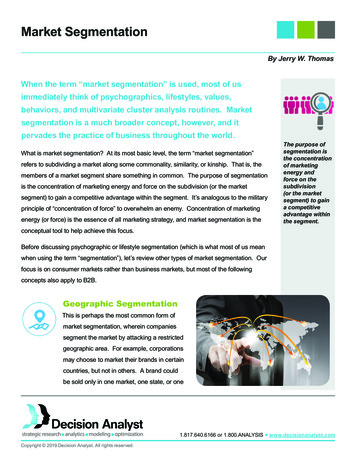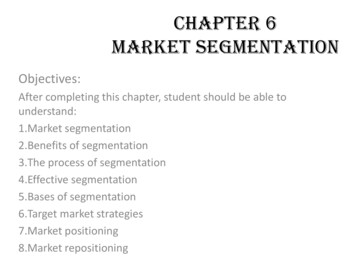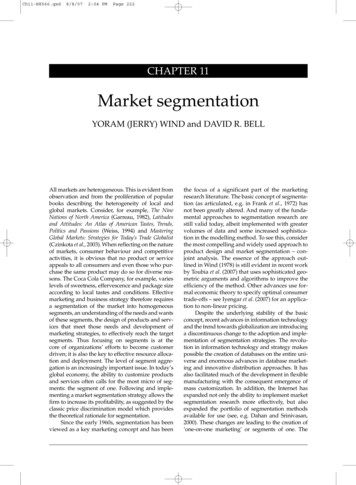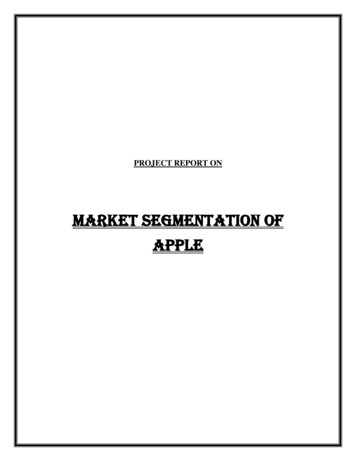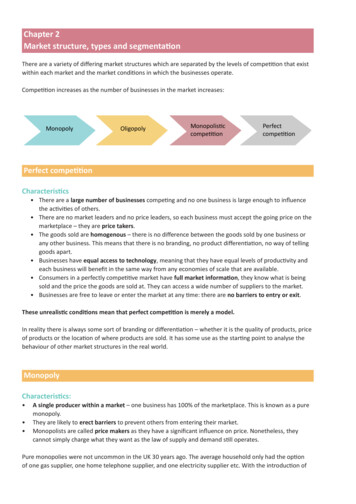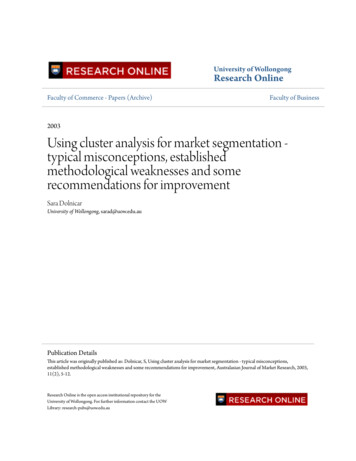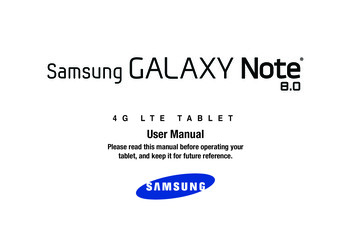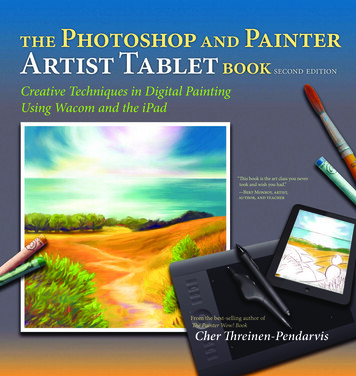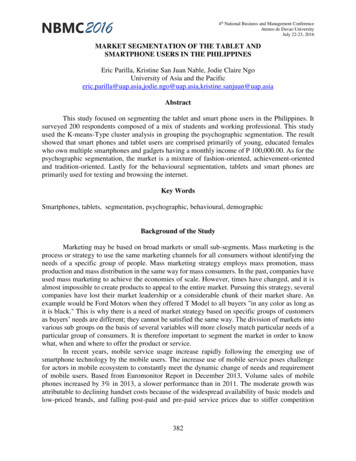
Transcription
4th National Business and Management ConferenceAteneo de Davao UniversityJuly 22-23, 2016MARKET SEGMENTATION OF THE TABLET ANDSMARTPHONE USERS IN THE PHILIPPINESEric Parilla, Kristine San Juan Nable, Jodie Claire NgoUniversity of Asia and the istine.sanjuan@uap.asiaAbstractThis study focused on segmenting the tablet and smart phone users in the Philippines. Itsurveyed 200 respondents composed of a mix of students and working professional. This studyused the K-means-Type cluster analysis in grouping the psychographic segmentation. The resultshowed that smart phones and tablet users are comprised primarily of young, educated femaleswho own multiple smartphones and gadgets having a monthly income of P 100,000.00. As for thepsychographic segmentation, the market is a mixture of fashion-oriented, achievement-orientedand tradition-oriented. Lastly for the behavioural segmentation, tablets and smart phones areprimarily used for texting and browsing the internet.Key WordsSmartphones, tablets, segmentation, psychographic, behavioural, demographicBackground of the StudyMarketing may be based on broad markets or small sub-segments. Mass marketing is theprocess or strategy to use the same marketing channels for all consumers without identifying theneeds of a specific group of people. Mass marketing strategy employs mass promotion, massproduction and mass distribution in the same way for mass consumers. In the past, companies haveused mass marketing to achieve the economies of scale. However, times have changed, and it isalmost impossible to create products to appeal to the entire market. Pursuing this strategy, severalcompanies have lost their market leadership or a considerable chunk of their market share. Anexample would be Ford Motors when they offered T Model to all buyers "in any color as long asit is black." This is why there is a need of market strategy based on specific groups of customersas buyers’ needs are different; they cannot be satisfied the same way. The division of markets intovarious sub groups on the basis of several variables will more closely match particular needs of aparticular group of consumers. It is therefore important to segment the market in order to knowwhat, when and where to offer the product or service.In recent years, mobile service usage increase rapidly following the emerging use ofsmartphone technology by the mobile users. The increase use of mobile service poses challengefor actors in mobile ecosystem to constantly meet the dynamic change of needs and requirementof mobile users. Based from Euromonitor Report in December 2013, Volume sales of mobilephones increased by 3% in 2013, a slower performance than in 2011. The moderate growth wasattributable to declining handset costs because of the widespread availability of basic models andlow-priced brands, and falling post-paid and pre-paid service prices due to stiffer competition382
4th National Business and Management ConferenceAteneo de Davao UniversityJuly 22-23, 2016between telecommunications companies. As a result, owning a mobile phone became moreaffordable in the country.According to the same report, Samsung Electronics Philippines Corp maintained its leadin mobile phones, accounting for a volume share of 28% in 2012. The South Korean-basedmanufacturer continued to strengthen its position in the category because of the high acceptanceof Samsung Galaxy smartphones, aggressive advertising and marketing campaigns, and largeinvestments in research and development, which enabled it to constantly introduce new modelswith innovative and technologically-advanced features. In 2012, the company also saw the largestvolume share increase within smartphones.In the Philippines, mobile and tablet usage had increased in the past years with theproliferation of cheap and affordable tablets and mobile phones. Many users of smart phones andtablets had also demanded newer features of their devices, which means that the basic call and textfeatures are no longer just what these users would like from their gadgets. One study (One DeviceResearch, 2014) showed however, that the current smartphone penetration rate in the Philippinesstands at 15 percent, the lowest in Southeast Asia but to increase by as much as 50% in the nextthree years. The study showed that there will be an optimistic increase of users of these gadgets.Market segmentation is a marketing strategy which involves dividing a broad targetmarket into subsets of consumers, businesses, or countries who have, or are perceived to have,common needs, interests, and priorities, and then designing and implementing strategies to targetthem. The importance of segmentation is it will enable the marketers to identify and design specificstrategies that will appeal to a specific group of the target market. This study therefore showedthe segmentation of the users of tablets and smart phones so that the manufacturers of these willbe able to design specific marketing mix strategies that will appeal to the segments.Statement of the ProblemThis study determined the demographic, psychographic, behavioral segmentation andpurchase decision considerations of the users of smart phones and tablets. Specifically it answeredthe following problems:1. What is the demographic profile of the respondents in terms of:a. Type of Ownership;b. Brand Owned;c. Age;d. Gender;e. Civil Status;f. Monthly Family Income; andg. Highest Educational Attainment;2. What is the psychographic segments of the smart phones and tablet users in thePhilippines?3. What are the behavioral segments of the smart phones and tablet users in the Philippines?4. What are the purchase decisions of smart phones and tablet users in the Philippines as to:a. Influencers in the purchase decision;b. Attributes;c. Brand-new or second hand purchase; andd. Location of the Purchase?383
4th National Business and Management ConferenceAteneo de Davao UniversityJuly 22-23, 2016Population and SampleThe study used a quota sampling method and focused on the Metro Manila smart phonesand tablet users. It surveyed 200 respondents which are a mix of students and workingprofessionals.Statistical MethodThis study used the K-Means-Type cluster Analysis in clustering the PsychographicSegmentation that classified the respondents through the four different orientations which are a)Achievement cluster, b) tradition-oriented, c) fashion-oriented and d) moderate oriented. There arethree groups that was compared to one another, and the highest among the three groups classifiedthe respondent based on the orientation with the highest score. To avoid confusion and to justifythat the highest score, an interval of 2 points determined if that orientation is the highest. On theother hand, moderate-orientation was merited if the scores are not 2 points higher or more than theother two orientations. This means that if the difference of the orientations was just one point, therespondent was classified under moderate-orientation. Also, the respondent is moderate-orientedif the highest score could not be determined.Presentation, Interpretation and Analysis of DataThis section of the study presents the analysis and interpretation of the data as gatheredfrom the questionnaire and follow up interviews. The responses were organized, tallied, tabulatedand presented in tables to facilitate their interpretation.Table 1. Demographic Profile of RespondentsIndicatorOwnershipSmart PhonesTabletsBothTotalBrand OwnedCherry MobileAppleSony EricksonSamsungBlackberryNokiaMultiple OwnershipTotalAge11-20 years old21-30 years old31-40 years old41-50 years 0%24%23%2%1%
4th National Business and Management ConferenceAteneo de Davao UniversityJuly 22-23, 2016IndicatorTotalGenderMaleFemaleTotalCivil StatusSingleMarriedTotalMonthly Income15,000 and 0-aboveTotalEducational AttainmentHigh School GraduateCollege UndergraduateCollege GraduatePost 100%2410076220012%50%38%1%100%Ownership. Out of the 200 respondents of this study, 57% owns smart phones and 37%owns both smart phones and tablets. This indicates that many Filipinos prefer the smart phonesbecause of its call-text feature as compared to tablets which is only used for gaming and forbrowsing the net. Smart phones can also become a gaming console and gadget used for browsingthe net. Moreover because many smart phones are more compact and easier to carry as comparedto tablets, it is more preferred by the consumers. One of the respondents said that because of thedual purpose of smart phones, she preferred to buy smart phone rather than the tablet.Brand Owned. The table shows that 38% of the respondents own multiple cellularphones/tablets and 34% of them own an Apple cellular phone/tablet. On the other hand, 15% saidthat they own Samsung smart phone/tablet. This shows that many Filipinos patronage foreignowned brands as compared to Philippine-made brands. Also we can deduced from this table thatmany Filipinos have multiple cellular phones/tablets and that they are not satisfied with owningonly one. The researcher asked the reasons of owning multiple phones/tablets and the respondentssaid that many of them are carrying phones or tablets because one is for personal use and anotheris for office use. Another reason that came up is that many smart phones/tablets have only shortbattery life span, so the other phone will become a reserve phone/tablet especially those that arealways on-the-go.The results of the study is not in accordance to the results of a well-known website thatreviews different aspects in technology. Pinoytechblog.com issued a survey which says that themost popular smart phone in the Philippines is MYPHONE and Cherry mobile. Samsung andIPHONE only came in third and fourth respectively. It can be attributed to the fact that the survey385
4th National Business and Management ConferenceAteneo de Davao UniversityJuly 22-23, 2016conducted by the website blog was nationwide so there was a diversity of respondents while thecurrent study only concentrated in Metro Manila.Age. Majority of the respondents are from the age range 11-20 years old. This means thatmany smart phones/tablet users belong to the young generation. The main characteristic f thisgeneration is that they are social and adventurous. This means that in order to penetrate the marketsmartphones/tablets should have added features that could capture videos/photos and can browsethe internet.Gender. 68% of the respondents are female and only 32 percent are male. According toresearch done by EDigitalResearch, a market research specialist in the United Kingdom, morefemale are using smart phones and tablets because there is an increase in the purchase throughonline retailing of fashion apparels. The same research also dictated that more female are usingsmart phones and tablets as compared to males.Civil Status. Majority of the respondents are single (79%). The main reason for this is thatsingle people have lesser priorities in their purchases since they still do not have a family andbecause of this they are more inclined in buying gadgets for themselves as compared with marriedindividuals that have other priorities.Monthly Income.49% or almost half of the respondents have monthly income of P100,000.00 and above. This means that this individuals have the capacity to purchase smart phonesand tablets that are a little expensive than the Philippine made phones and tablets. This result isaligned to the results of brand ownership where Apple and Samsung came in first and third becausethese are the brands that are more expensive than the other brands.Educational Attainment. Half of the respondents are still college undergraduates (50%).This coincides with the results as to their age where half of the respondents are from the age rangeof 11-20 years old. In this group of respondents when the researchers asked their preferences overa smart phone and tablet, they said that most of them used their tablets for researching home worksand taking down notes. There is also a huge group of college graduates as respondents comprisingof 38%. When asked about their preferences, the respondents said that they prefer their smartphones and tablets to be sleek and fashionable.Psychographic SegmentationPsychographic segmentation is dividing your market based upon consumer personalitytraits, values, attitudes, interests and lifestyles. Segmentation will allow you to better develop andmarket your products because there will be a more precise match between the product and eachsegment's needs and wants (study.com, 2013).In this research there are 4 types of segments used namely fashion-oriented, achievementoriented, traditional-oriented and moderate-oriented. Fashion-oriented people like to keep up withlatest fashion. They prefer fashionable than being practical. They like to try new products and newbrands. They lack independence and are prone to be affected by other people's opinions. Theyprefer to be told what to do rather than take responsibility. They are satisfied with their currentcondition and don't want change. Although they like latest fashion, they are generally priceconscious. They like to bargain to get the cheapest product. Therefore, they are more inclined tobuy fake brand. They pay attention to advertisements and are easily swayed due to their impulsiveand fashion-orientation.On the other hand, achievement oriented people place a lot of value on their personalachievement, hoping to get to the very top in their career. They are full of self-confidence andpursue a life of challenge, novelty and change. They are generally rational, decisive and386
4th National Business and Management ConferenceAteneo de Davao UniversityJuly 22-23, 2016
Market segmentation is a marketing strategy which involves dividing a broad target market into subsets of consumers, businesses, or countries who have, or are

